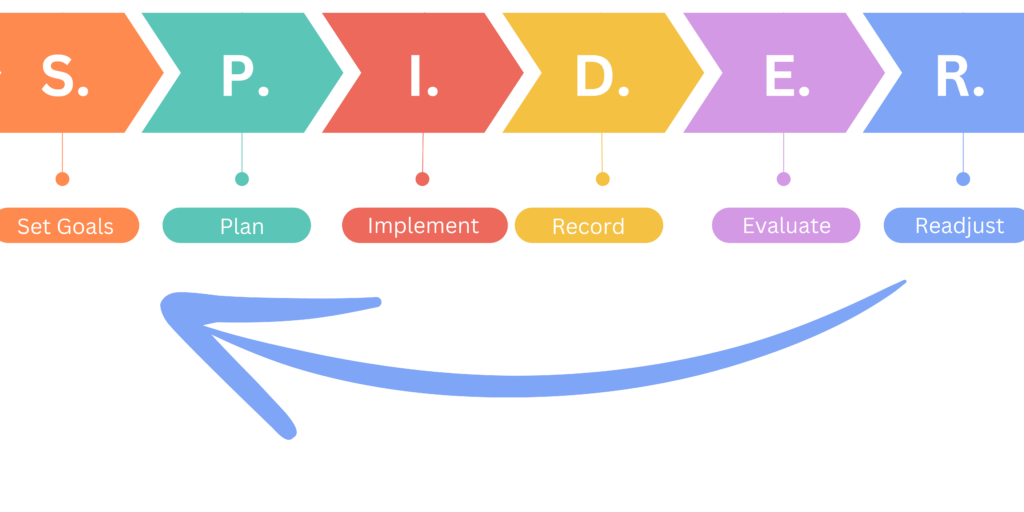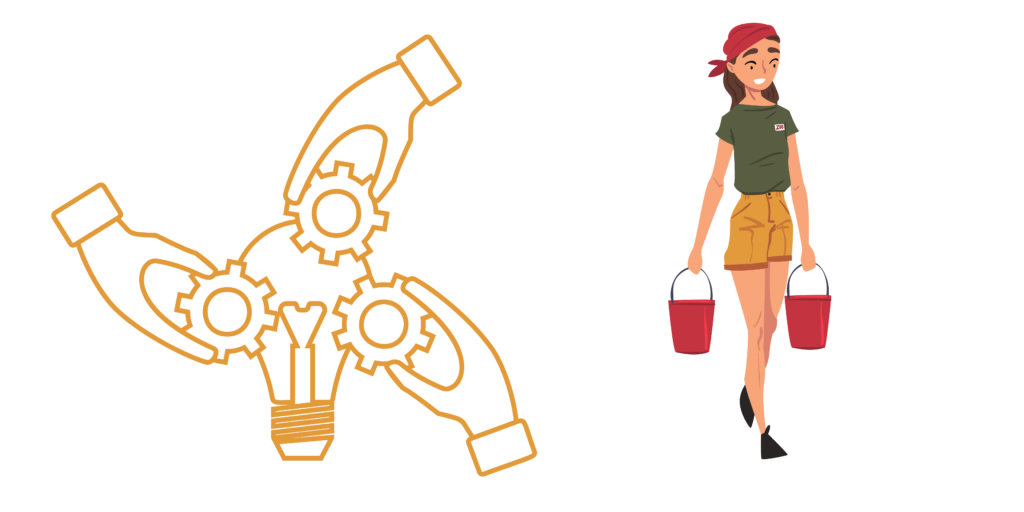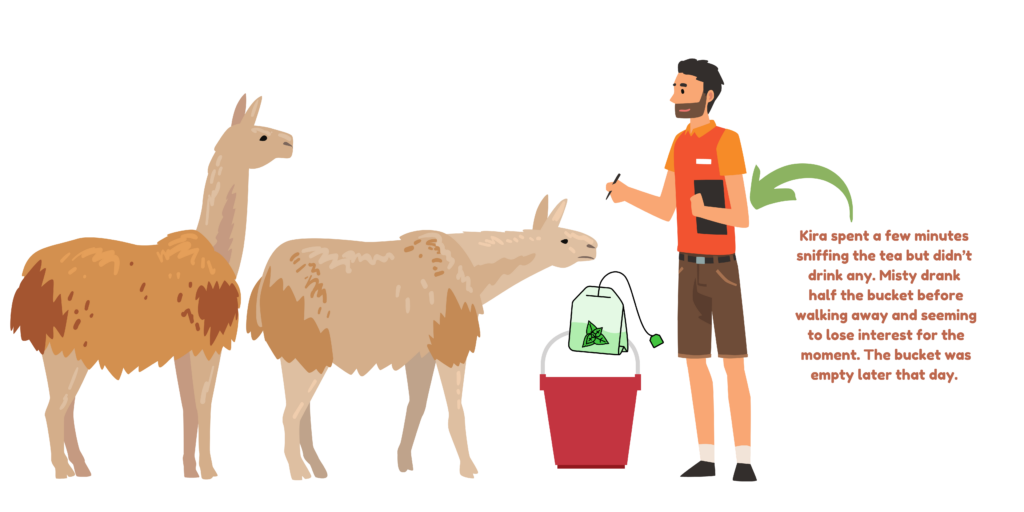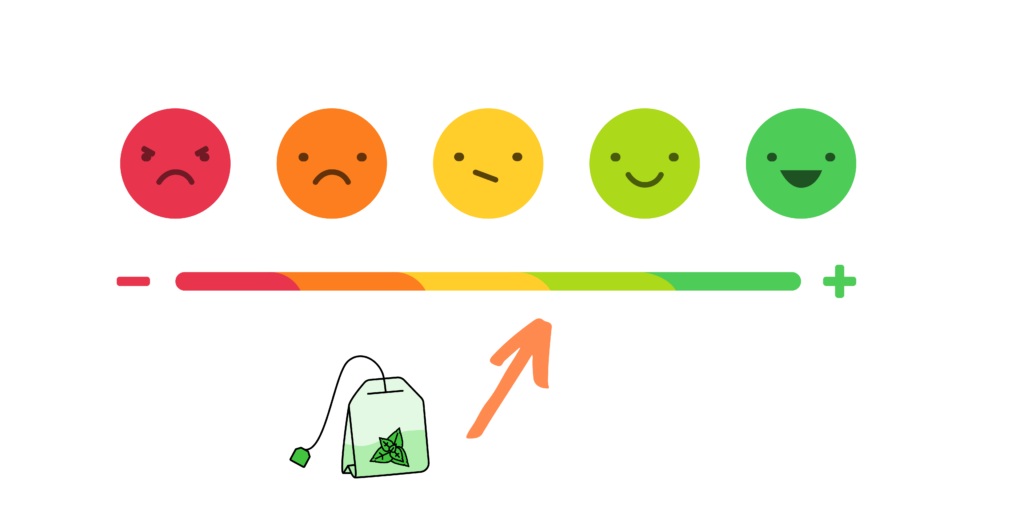
One of the biggest hurdles to developing a successful enrichment program is figuring out how to start and maintain the various facets involved. In our “Time To Thrive” enrichment series, we have covered a variety of topics from the importance of enrichment, the categories of enrichment, and safety considerations to species-specific and individual considerations. All these elements (and more) are vital knowledge when contemplating an enrichment program at your animal sanctuary. In this resource we will look at a commonly used framework, the S.P.I.D.E.R. Framework, that can provide a map of sorts to help you and your care staff establish, grow, and maintain a successful program for the residents under your care. Let’s get started!
The S.P.I.D.E.R. Framework

Developed in the 90s by zookeepers at Disney’s Animal Kingdom, the S.P.I.D.E.R. Framework has been utilized with much success by a variety of animal organizations, both compassionate and noncompassionate. While we do not support exploitative practices or spaces, we understand that some available resources, scientific and anecdotal, can be used compassionately even if their original creation or study findings were exploitative. This framework is essentially made up of 6 steps designed to help caregivers create and maintain a successful enrichment program for residents under their care. Each step addresses an important aspect of the enrichment process. Let’s break this down!
Setting Goals

Setting goals is just what it sounds like. This step allows you to consider what a species and individual needs and how enrichment can help meet those needs. This step is actually two steps: 1. Learning about natural species histories and individual histories and 2. Deciding what behaviors you want to increase (exploring living spaces) or decrease (feather-plucking).
For this step to be successful, it requires learning about the species’ natural (and individual) history. There are many questions your care staff can ask, leading to answers that will help guide your enrichment choices. You can find a list of example questions in our “Time To Thrive: Considering Enrichment For Species And Individuals” resource!
Learning about the history of your resident species can provide insight into how they navigate the world, in addition to what’s important to them as a species. Not only can this help you develop good enrichment plans, but it can help you understand them and provide better care in general.
In addition to learning about their natural history, it is important to know as much as possible about the histories of individual residents. Be sure to consider things like personality (shy, bold, rambunctious, timid), health (mobility issues, metabolic disease, dental issues), and history (Are they coming from a traumatic background? Do they have experience interacting with novel things? How did they respond?).
Here is an example of considering an individual’s specific needs when setting goals:
Misty and Kira are fairly recent llama rescues and care staff have noticed that Misty seems a bit timid. They are both in quarantineThe policy or space in which an individual is separately housed away from others as a preventative measure to protect other residents from potentially contagious health conditions, such as in the case of new residents or residents who may have been exposed to certain diseases. together and their temporary space doesn’t have the most interesting features. Care staff would like to provide both Misty and Kira with a bit of novelty while they wait out their quarantine time. Kira has explored their living spaceThe indoor or outdoor area where an animal resident lives, eats, and rests. pretty thoroughly. However, Misty seems reticent to leave the sheltered area of their living space. Care staff want Misty and Kira to have new and interesting experiences to enrich their lives. Because Misty seems unsure of exploring her larger surroundings, the care staff set a goal to encourage Misty (and Kira) to engage with novel objects and flavors as a way of breaking up the routine of their days.
Planning

Once you have set a goal, it is time to plan how you are going to achieve that goal. This is the fun brainstorming part! In the planning stage, you’ll need to consider what type of enrichment to offer, the safety of the proposed enrichment, the cost of materials needed, how to obtain the materials, who will obtain them, the level of difficulty in making the enrichment, who will make it, and the best time to provide the enrichment. It sounds like a lot on paper but is generally fairly straightforward and many types of enrichment are easy and inexpensive. Now that you have a plan, you are ready to put it into action!
Here is an example of planning enrichment based on the goals set:
While care staff ideally would like to see both Kira and Misty exploring their entire outdoor living area, they recognize that starting slow may be best due to Misty’s lack of security in her new space. They decide to start with an easy, basic nutritional enrichment activity. They decide they will do this by using two water buckets they already have on hand and a few mint teabags purchased by Heath, the care manager, with the company card. Then Seharra, their caregiverSomeone who provides daily care, specifically for animal residents at an animal sanctuary, shelter, or rescue., will fill the buckets in the morning, put tea bags in each, and set them in the sun. Later in the day after morning routines are finished, they will remove the tea bags and take them to Misty and Kira.
Implementation

Congratulations, you get to put all that goal-setting and planning to good use and improve the lives of residents under your care! Implementing enrichment involves the actual provision of enrichment to the residents which can be done on the fly or as a scheduled activity. The benefit of using calendars and scheduling enrichment is the ability to keep track of who is being given what enrichment, where, and at what time. There isn’t a one-size-fits-all approach. Each sanctuary is different, and what works best for one may not work for another, and that’s okay! Incorporating enrichment into a regular care routine may seem overwhelming, but there are ways to approach it that can make it manageable and even fun! While it may seem hard to get started, exploring and trying out different enrichment calendars can help your enrichment program succeed.
You can learn about different ways to approach scheduling enrichment in our “Time To Thrive: Enrichment Calendar Styles” resource. It’s okay to try out different styles until you find what works best for your residents and care staff. Now that the enrichment has been provided, you may think implementation is the last step. However, there are still three more to go!
Here is an example of implementing enrichment based on the plans made:
“Following the plan set by care staff, Seharra places one bucket near the main water source for Misty and Kira and another further out in their paddock.”
Documentation

Documenting outcomes and keeping detailed records can make a huge difference in the success of an enrichment program. In addition to ensuring all care staff have access to the same information about the individual receiving the enrichment, it also allows you to keep track of the resident’s reaction to the enrichment. You do this to evaluate the enrichment (next step!) and discover if it is a positive experience and successful for its intended purpose. You will want to record the individual(s) name(s), where their living area is, the date, the time (it’s more important than you might think!), a brief description of the enrichment activity/item, how it was presented, and how residents reacted to it at that moment and later on in the day.
We recommend checking out our “The Caregiver’s Guide To Developing Your Observation Skills” resource to improve your observation skills. Think outside the box and consider taking a visual recording of the enrichment activity so other care staff can see or use software that also you to make detailed notes regarding resident behavior.
Here is an example of documenting based on the enrichment observed:
After Seharra provides Misty and Kira with the enrichment, Max observes what they do and notes that Misty does approach a bucket and sniff it but walks away. Kira, drinks quite a bit from the bucket and other care staff observe her drinking from the bucket later in the day. At no point did anyone see Misty do more than approach and sniff the bucket three times.
Evaluation

Now it’s time to sit down together as a care team and evaluate the success of the enrichment by reviewing the information you documented and discuss. Did the resident interact with the enrichment? What behaviors did they demonstrate? Did it meet the goal you set at the beginning of increasing or decreasing specific behaviors? Sometimes the answers are a little more complex than yes or no and that’s why it’s important to discuss as a team. Perhaps it wasn’t a complete success but a caregiver has an idea that could improve the chances of meeting the original goal. This is where our next, and last, step comes into play.
Here is an example of evaluating enrichment based on the documentation:
This nutritional enrichment activity was a success for Kira but not so for Misty. While she did show some interest, she became disinterested fairly quickly and walked away. though she did approach it again later. Perhaps, Misty simply isn’t a fan of mint.
Readjustment

There may be times when the enrichment was clearly a success or failure but often it may land somewhere in the middle. In these cases, adjustments can be made and another attempt made.
Here is an example of readjusting enrichment based on the outcomes:
In this case, caregivers followed the original plan but added another flavor, raspberry to one of the buckets. This time Misty was seen sniffing both buckets and walking away but then coming back to sip from the raspberry bucket! It may not always succeed and you’ll need to scrap the whole idea altogether. Thats okay! You can come up with new ideas to try.
A Note On Prioritisation
One area that isn’t explicitly mentioned in the S.P.I.D.E.R. Framework is prioritization. Establishing an enrichment program can be overwhelming which is why we have a resource “5 Steps To Simplify Enrichment”. This is a bit of a framework of its own and we recommend you check it out. Depending on the size of your resident population, the number of care staff and volunteers, and budget considerations, knowing where to start can present an obstacle to getting the ball rolling. One of the questions that this resource asks is “Who is in greater need of enrichment”? While we want every resident to have enrichment opportunities it may make sense to start start with individuals that are in particular need.
Good questions to start with include:
- Are there some species that have more barren living spaces than others?
- Are some groups further from “the action” of the rest of the sanctuary?
- Are there groups with social conflict or residents who are not observed engaging with their environment?
- Is there someone who is currently alone in quarantine or is temporarily isolated?
- Are there specific individuals you have seen displaying abnormal behavior?
The answer to these questions can help you prioritize where to start. Who may be in the most need of enrichment intervention? The rest of the resource offers more questions and answers on how to move forward once you have identified a high-priority resident(s) that is in more immediate need of enrichment.
And that’s it! As seen in the example above, the process can at times be circular and you can end up setting goals again after readjustment or you may find success on the first go around! Now this specific framework may not be the best fit for your sanctuary so feel free to adjust it as needed. However, whatever framework you use should come from a foundation of knowledge of resident species and individuals, safety, and be effective in meeting set goals. Keeping records and finding an enrichment schedule that works for your care team will help ensure the success of your enrichment program! Do you have an enrichment program at your sanctuary? If so, we would love to hear about it!
Infographic
Want an easy way to share the basics of the S.P.I.D.E.R. Enrichment Framework with others? Just check out the infographic below!
SPIDER FRAMEWORK INFOGRAPHIC by Amber D Barnes
SOURCES
THE S.P.I.D.E.R. Framework | Animal Enrichment (Non-Compassionate Source)
Setting Goals Example | ZooAn organization where animals, either rescued, bought, borrowed, or bred, are kept, typically for the benefit of human visitor interest. Enrichment (Non-Compassionate Source)
Putting The ” E ” In SPIDER: Evolving Trends In The Evaluation Of Environmental Enrichment Efficacy In Zoological Settings | Animal Behavior And Cognition (Non-Compassionate Source)
Enrichment Gone Wrong | The Shape Of Enrichment (Non-Compassionate Source)
Enrichment Provision | Wildlife Welfare (Non-Compassionate Source)
Non-Compassionate Source?
If a source includes the (Non-Compassionate Source) tag, it means that we do not endorse that particular source’s views about animals, even if some of their insights are valuable from a care perspective. See a more detailed explanation here.








